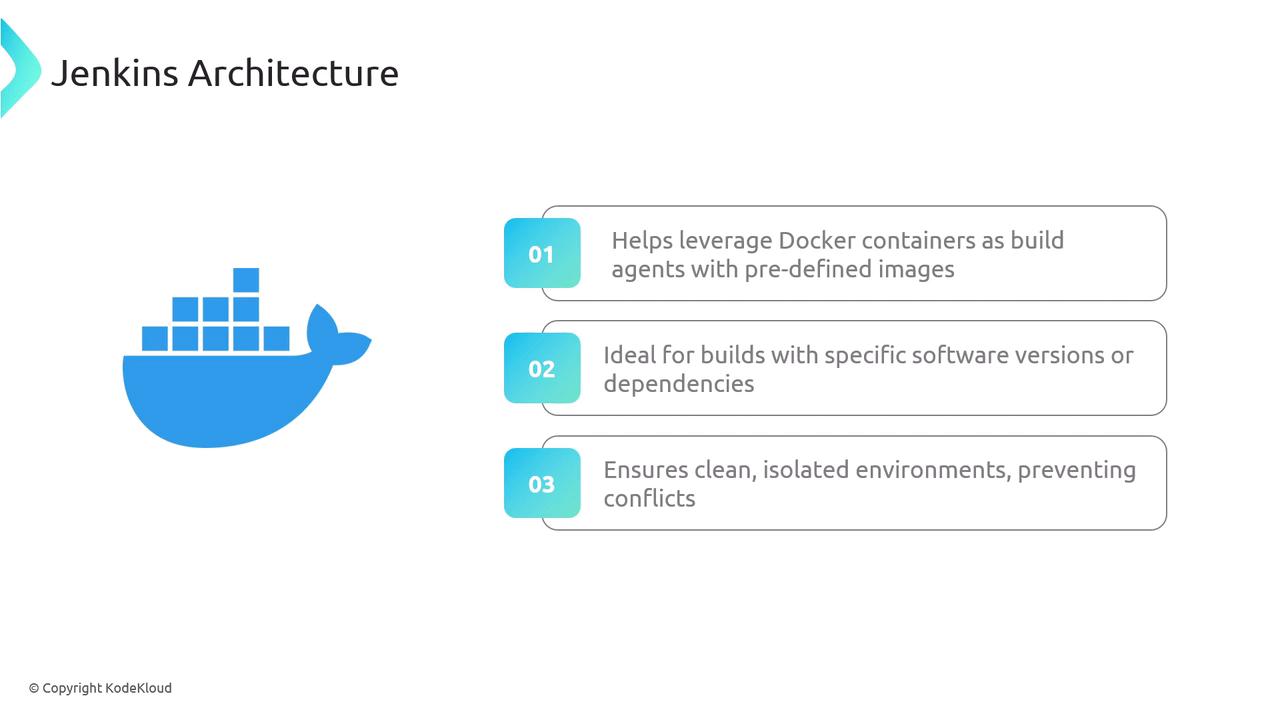Advanced Jenkins
Agents and Nodes in Jenkins
Types of Agents
Jenkins agents (also known as build nodes) provide executors that run your CI/CD workloads. Configured through a Jenkinsfile, each agent specifies how a worker node connects to the controller—using SSH, JNLP, or other protocols—and includes required build tools (e.g., JDK, Node.js).

When using Docker, you containerize all dependencies into an image and spin up an isolated agent for each job. This ensures consistency across builds, simplifies version management, and avoids “works on my machine” problems.

Jenkins supports a variety of agent types to fit different CI/CD requirements. Below is a quick overview:
| Agent Type | Description | Use Case |
|---|---|---|
| Permanent Agents | Statically configured nodes always online, with pre-installed tools and fixed resources. | Stable builds with consistent toolchains |
| Docker Agents | Ephemeral containers created from custom images, destroyed after each build. | Isolation, reproducibility, version control |
| Cloud-Based Agents | On-demand VMs or Kubernetes Pods via cloud plugins (AWS, Azure, GCP). Auto-scaled per workload. | Elastic scaling and cost optimization |
| Label-Based Agents | Nodes tagged with labels (e.g., java, windows). Pipelines request labels instead of nodes. | Flexible matching based on node capabilities |
![]()
Declarative Pipeline Examples
Below are common Declarative Pipeline patterns for specifying agents in a Jenkinsfile.
1. Any Available Agent
Use agent any to let Jenkins route the job to the next free executor:
pipeline {
agent any
stages {
stage('Build') {
steps {
sh 'echo Running on ${NODE_NAME}'
}
}
}
}
2. Label-Based Agent
Specify agent { label 'my-agent' } to target nodes matching a label:
pipeline {
agent { label 'my-agent' }
stages {
stage('Build') {
steps {
sh 'echo Executing on ${NODE_NAME} (label: my-agent)'
}
}
}
}
Note
Ensure that your Jenkins controller has at least one node configured with the my-agent label. Otherwise, builds will remain queued.
3. Docker Agent
Spin up a Docker container as your build environment. Here we mount the NPM cache for faster installs:
pipeline {
agent {
docker {
image 'node:latest'
args '-v $HOME/.npm:/root/.npm'
}
}
stages {
stage('Build') {
steps {
sh 'node --version && npm --version'
}
}
}
}
Warning
Mounting host directories into containers can expose sensitive data. Validate args parameters before use.
4. Default and Stage-Specific Agents
Define a default agent at pipeline level and override it per stage:
pipeline {
agent { label 'my-agent' } // Default for all stages
stages {
stage('Build') {
agent {
docker { image 'node:14-alpine' }
}
steps {
sh 'echo Building in Docker: ${NODE_NAME}'
}
}
stage('Test') {
steps {
sh 'echo Testing on default agent: ${NODE_NAME}'
}
}
}
}
In this setup, the Build stage runs inside a Node.js Docker container, while Test uses the static my-agent.
Links and References
Watch Video
Watch video content